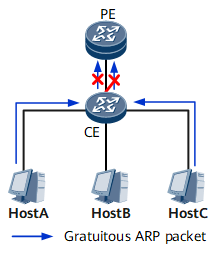Gratuitous ARP Packet Discarding
Background Information
When a device is connected to a network for the first time, the device broadcasts gratuitous Address Resolution Protocol (ARP) packets to announce its existence and check whether its IP address conflicts with the IP address of any other device in the broadcast domain. Any device can send gratuitous ARP packets and receive gratuitous ARP packets without authentication. As a result, a large number of gratuitous ARP packets can be generated, causing devices to be busy processing these packets. This process overloads the CPU and affects the processing of other services.
You can solve this problem by configuring gratuitous ARP packet discarding on the device. After gratuitous ARP packet discarding is configured, the device discards all received gratuitous ARP packets to prevent excessive CPU consumption.
As shown in Figure 1, after accessing the network, host A and host C broadcast gratuitous ARP packets to advertise their existence. After receiving the gratuitous ARP packets, the CE forwards the gratuitous ARP packets to the PE. If gratuitous ARP packet discarding is not configure on the provider edge (PE), the PE obtains the address information about host A and host C from the gratuitous ARP packets and generates ARP entries.
If gratuitous ARP packet discarding is configured on the PE, the PE discards the gratuitous ARP packets from host A and host C instead of learning the packet address information. In this manner, CPU resource consumption is reduced, and users' services are not affected.
Usage Scenario
Gratuitous ARP packet discarding is deployed on access and aggregation devices.
Benefits
Gratuitous ARP packet discarding helps prevent CPU exhaustion.
